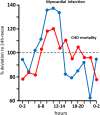Effects of Angiotensin-Converting Enzyme Inhibitors and Angiotensin Receptor Blockers on Prothrombotic Processes and Myocardial Infarction Risk
- PMID: 27580998
- PMCID: PMC5126203
- DOI: 10.1007/s40256-016-0185-0
Effects of Angiotensin-Converting Enzyme Inhibitors and Angiotensin Receptor Blockers on Prothrombotic Processes and Myocardial Infarction Risk
Abstract
Acute ischemic events occur most frequently at dawn and in the early hours of the morning. The development of these severe clinical events exhibits a temporal relationship with changes in various hemodynamic, prothrombotic, and hormonal processes. The authors highlight not only these relationships but also the potential protective effect of increased bradykinin levels and the inhibition of different angiotensin II (AT-II) receptors (AT2, AT4) against unfavorable prothrombotic influences, which-based on studies to date-decreases the risk of acute cardiovascular events. Comparisons are presented between the different effects of angiotensin-converting enzyme inhibitors and angiotensin receptor blockers on factors that influence thrombus formation and myocardial infarction risk.
Conflict of interest statement
Compliance with Ethical StandardsThe authors take responsibility for all aspects of the reliability and freedom from bias of the data presented and their discussed interpretation.FundingNo external funding was used in the preparation of this manuscript.Conflicts of interestCsaba András Dézsi and Veronika Szentes have no conflicts of interest that might be relevant to the contents of this manuscript.
Figures






Similar articles
-
Clinical trials evaluating angiotensin-converting enzyme inhibitors and angiotensin receptor blockers in the setting of acute myocardial infarction.Expert Opin Investig Drugs. 2003 Mar;12(3):501-7. doi: 10.1517/13543784.12.3.501. Expert Opin Investig Drugs. 2003. PMID: 12605571 Review.
-
Comparison between angiotensin-converting enzyme inhibitors and angiotensin receptor blockers on the risk of myocardial infarction, stroke and death: a meta-analysis.J Hypertens. 2008 Jul;26(7):1282-9. doi: 10.1097/HJH.0b013e328306ebe2. J Hypertens. 2008. PMID: 18550998
-
Effects of captopril and angiotensin II receptor blockers (AT1, AT2) on myocardial ischemia-reperfusion induced infarct size.Cytokine. 2011 Dec;56(3):688-94. doi: 10.1016/j.cyto.2011.09.002. Epub 2011 Oct 4. Cytokine. 2011. PMID: 21975128
-
Renin-angiotensin system blockers in cardiac surgery.J Crit Care. 2015 Jun;30(3):613-8. doi: 10.1016/j.jcrc.2015.02.017. Epub 2015 Mar 5. J Crit Care. 2015. PMID: 25813547 Review.
-
Comparative Effectiveness of Angiotensin II Receptor Blockers Versus Angiotensin-Converting Enzyme Inhibitors Following Contemporary Treatments in Patients with Acute Myocardial Infarction: Results from the Korean Working Group in Myocardial Infarction (KorMI) Registry.Am J Cardiovasc Drugs. 2015 Dec;15(6):439-49. doi: 10.1007/s40256-015-0140-5. Am J Cardiovasc Drugs. 2015. PMID: 26153396
Cited by
-
The Pivotal Role of Angiotensin-Converting Enzyme Inhibitors and Angiotensin II Receptor Blockers in Hypertension Management and Cardiovascular and Renal Protection: A Critical Appraisal and Comparison of International Guidelines.Am J Cardiovasc Drugs. 2023 Nov;23(6):663-682. doi: 10.1007/s40256-023-00605-5. Epub 2023 Sep 5. Am J Cardiovasc Drugs. 2023. PMID: 37668854 Free PMC article. Review.
-
The Rare Occurrence of a Left Atrial Thrombus in a Dog.Case Rep Vet Med. 2020 Oct 22;2020:8848627. doi: 10.1155/2020/8848627. eCollection 2020. Case Rep Vet Med. 2020. PMID: 33149956 Free PMC article.
-
ACE Inhibitors and Angiotensin Receptor Blockers for the Primary and Secondary Prevention of Cardiovascular Outcomes: Recommendations from the 2024 Egyptian Cardiology Expert Consensus in Collaboration with the CVREP Foundation.Cardiol Ther. 2024 Dec;13(4):707-736. doi: 10.1007/s40119-024-00381-6. Epub 2024 Oct 25. Cardiol Ther. 2024. PMID: 39455534 Free PMC article.
-
Management of Diabetes and Hypertension within the Gulf Region: Updates on Treatment Practices and Therapies.Diabetes Ther. 2022 Jul;13(7):1253-1280. doi: 10.1007/s13300-022-01282-4. Epub 2022 Jun 9. Diabetes Ther. 2022. PMID: 35679010 Free PMC article. Review.
-
Antecedent use of renin-angiotensin system inhibitors is associated with reduced mortality in elderly hypertensive Covid-19 patients.J Hypertens. 2022 Apr 1;40(4):666-674. doi: 10.1097/HJH.0000000000003059. J Hypertens. 2022. PMID: 34889863 Free PMC article.
References
-
- Organisation for Economic Co-operation and Development. Health at a Glance 2015: OECD Indicators. Paris: OECD Publishing; 2015. doi:10.1787/health_glance-2015-en.
-
- Willerson JT, Holmes DR Jr (eds) Coronary Heart Disease Syndromes: pathophysiology and clinical recognition. In: Coronary artery disease. London: Springer; 2015. p. 365–407.
Publication types
MeSH terms
Substances
LinkOut - more resources
Full Text Sources
Other Literature Sources
Medical

